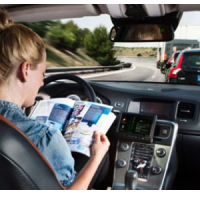California Will Blow Self-Imposed Deadline for Driverless Cars

CNN has christened the Google driverless car prototype “adorable” and other media have proclaimed the vehicle nearly road worthy, but customers won’t be lining up to buy one at least until the state’s Department of Motor Vehicles (DMV) comes up with safety rules.
That was supposed to happen by January 1, but won’t.
State legislation passed in 2012, which got the ball rolling for driverless-car development, required that DMV come up with guidelines for road testing and rules for gaining various certifications, including one for safety, before sales commence. The state announced road test guidelines in May but didn’t get far on the certifications.
The DMV knew it wasn’t capable of conjuring up the rules, according to the Associated Press, so it asked the industry if anyone wanted to create a program. Four companies came forward, two from Europe and two from Ohio, but no one felt comfortable creating a program for technology that doesn’t actually exist yet in a finished state.
So next month, the DMV will conduct a workshop for interested public and private parties to brainstorm about safety standards and related issues. They will have the plain vanilla choices of allowing manufacturers to self-certify (Google’s favorite), require independent third-party certification or have the state do it all or can create their own hybrid.
Meanwhile, road testing continues apace. Seven companies—Cadillac, Tesla, Google, Volvo, Audi, Mercedes-Benz and Nissan—are working on products that, realistically, won’t be in showrooms for years. Google predicted 2017 and other companies 2020.
They are driving their products around on public streets while grappling with questions about how to deal with computer malfunctions, the backup role of human beings, sorting out snowflakes and hail from road impediments, coping with roadwork not on maps, dodging pedestrians stumbling into the street and myriad other challenges. Sensors, already deployed in today’s cars, are used to create 3D maps of the surroundings while the computer uses preprogrammed responses to events real and predictable for operation of the car.
Google, which led the push for the 2012 enabling legislation, is leading the charge for self-certification and will press its case as the process unfolds. They will have plenty of support from other manufacturers. Jonathan Handel linked to videos from Volkswagen and Chrysler spokespeople extolling the automobile industry’s solid safety track record.
“It's not like any manufacturer is trying to skirt around some safety rules,” Chrysler’s Ross Good told the DMV at a workshop in 2013. VW’s Barbara Wendling told a 2014 workshop that she had “no worries that anybody in the industry is going to put an unsafe product into California or any other state.”
Perish the thought. Or, at least, GM and Toyota would like the thought perished after the former’s defective ignition switch it hid from the public killed more than 300 people and the latter’s acceleration problems resulted in at least 85 deaths. Future vehicles loaded with new, even-more complicated technology certainly won’t pose those kinds of issues.
–Ken Broder
To Learn More:
California Puzzles over Safety of Driverless Cars (by Justin Pritchard, Associated Press)
California DMV Will Blow Its Deadline on Rules for Self-Driving Cars (by Damon Lavrinc, Jalopnik)
Autonomous Cars by 2020 May be Ahead of the Legislation to Drive (by Sally Bartlett, BizTek Mojo)
How Do We Know Driverless Cars Are Safe? Google Says “Trust Us” (by Jonathan Handel, Huffington Post)
Google Takes Its Driverless Car on a Tour of Its California Campus―but There's Still No Word on When the Vehicles Will Go on Sale (by Victoria Woollaston and Sarah Griffiths, London Daily Mail)
DMV Puts Google Car Drivers Back Behind the Steering Wheel (by Ken Broder, AllGov California)
- Top Stories
- Controversies
- Where is the Money Going?
- California and the Nation
- Appointments and Resignations
- Unusual News
- Latest News
- California Forbids U.S. Immigration Agents from Pretending to be Police
- California Lawmakers Urged to Strip “Self-Dealing” Tax Board of Its Duties
- Big Oil’s Grip on California
- Santa Cruz Police See Homeland Security Betrayal in Use of Gang Roundup as Cover for Immigration Raid
- Oil Companies Face Deadline to Stop Polluting California Groundwater





